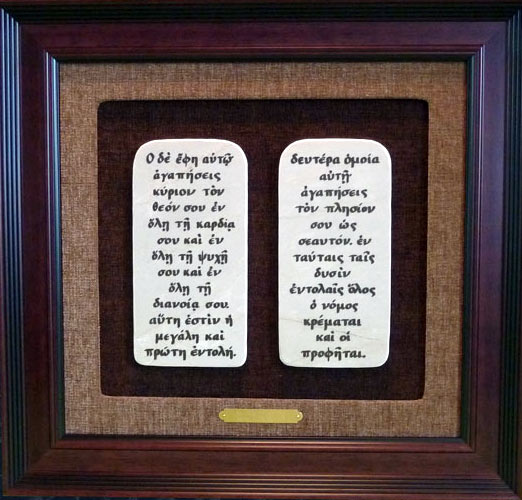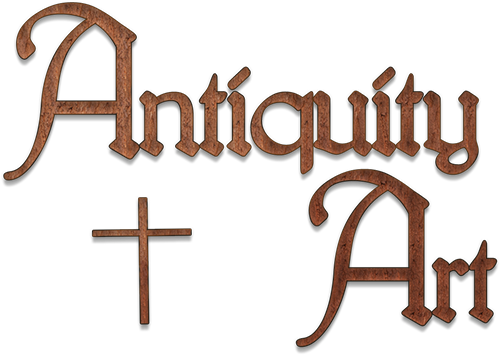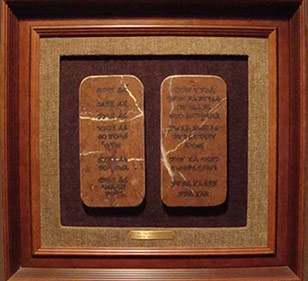The Two Great Commandments Koine Greek 65AD
The art shown is an authentic, artistic replication of original manuscripts still used as source documents for modern biblical translations.
Here we reverently display Matthew’s gospel in a medium an ancient Christian artist might have used 2,000 years ago.
The Bible scripture on the right can be read in nearly every language on earth, in any of its thousands of translations as Matthew 22: 37-40. Following is an English translation as it appears in the New American Bible: And he said to him, “You shall love the Lord, your God, with all your heart, with all your soul, and with all your mind. This is the greatest and the first commandment. The second is like it: You shall love your neighbor as yourself. The whole law and the prophets depend on these two commandments.”
That is how the writing appears now. But in 65 AD the New Testament had not yet been organized into the structure we have today. We waited 1500 years for a means to reference the books and verses of the New Testament as we can now. In 65 AD it had not yet been named Matthew 22:37-40. It was a singular manuscript written in Koine Greek. During the first century it, like the other three gospels, was known to be inspired by the Holy Spirit, and it was treated with reverence. The art shown is Matthew’s original testimony. Not a word, not a jot nor a tittle has been added to it nor subtracted from it. We believe religious art, reverently displayed with pride of placement, in our homes, schools and work places, can be an effective positive cultural counterbalance to many of the sometimes negative influences foisted by more insistent worldly cultures.

The Two Great Commandments
The Two Great Commandments: Matthew 22:37- 40
Koine Greek circa 65 AD
- Outside dimensions
- Width: 18 inches
- Height: 17 inches
- Depth: 1.375 inches
All prices include shipping cost.
Commentary
A Pharisee asks, “Teacher, which commandment of the law is the greatest?” Matthew tells us that Pharisees and Scribes were plotting how they might trip him in speech, attempting to put him at odds with either Roman or Jewish authorities. It is within this backdrop of treachery and hypocrisy Jesus holds forth for love and truth. He quotes two passages from the books of law. These divine instructions were not a new teaching; they were imprinted in our hearts at our beginning and have been retold to us many times since. It is a teaching we are unbearably slow to learn and implement. We hear, but we don’t understand. We have trouble understanding what love is and from the beginning have developed practices better suited to what it is not. When the Word was made flesh, and dwelt among us much of the Lord’s three year public ministry was spent defining what love of God and neighbor is; he illustrates this love for us within the confines of extremely adverse situations, he teaches us love is wholehearted, without reservation, without self-interest, and without conditions. If we study lives of saints, we might conclude that though conditions never seem to improve enough to make loving any easier, as we trudge along we do get better at it with practice.
Jesus quoted two commandments, the first from Deuteronomy 6:5, the second, Leviticus 19:18. Logic dictates the dialogue between Jesus and the Pharisee was in Palestinian Aramaic. Unfortunately no manuscripts recording Jesus’ response in native tongue are known to have survived to our time. We do know the earliest surviving manuscripts were written in the common language of the time, Koine Greek, approximately 65 A.D. It is in this way many anonymous scribes passed on to following generations the sacred words of Jesus.
As the word of God has been passed down to us, we have set in stone an artistic replication of the original manuscripts once used to form the canons of scripture we recognize as the Holy Bible. Through the centuries a succession of scribes, together with those who have collected and preserved their works, have brought to us from antiquity the authenticity, profound wisdom, and austere beauty of these holy words. May we join with them who have gone before us.
Cloth, Wood and stone
For the manuscripts tablets, we selected a dense smooth marble that is beige in its general color but also has sporadic and subtle variations of red-brown hues which course through this beautiful marble.
Each Tablet of stone is cut to size on our diamond blade wet saw and then individually shaped by hand on our wet abrasions wheels to give each a unique and artful shape. Even though no two tablets are identical, part of our art is to find, cut, and shape two tablets perfect for each other.
The Greek characters of each tablet’s scriptures are burned into the marble with Hydrochloric Acid, one pair at a time. Each piece is considered as to density and impurities and burns in the acid a different amount of time. Each pair etches differently and no two sets are alike. Each pair of tablets is unique.
We have mounted The Two Great Commandments on a heavily textured Chenille fabric mat in a deep dark brown called espresso. Framing the two tablets and the first mat is a second mat, also in Chenille fabric, a lighter contrasting color called mocha.
We have placed a brass Title Plate on the second mat, it reads:
Matthew 22:37-40
Koine Greek ca 65 AD
The scriptures are handsomely framed in mahogany.
The back of the frame is home to the interlinear transliteration and commentary. Both translation and commentary are written in a classic calligraphic style, imprinted with an attractive and complimentary chocolate brown ink, on a golden colored, parchment like, heavy card stock paper. It has a sturdy, good-looking brass hanger that easily supports the 9 pound weight of the art. We have had ours hung, this way, for over thirty years.

